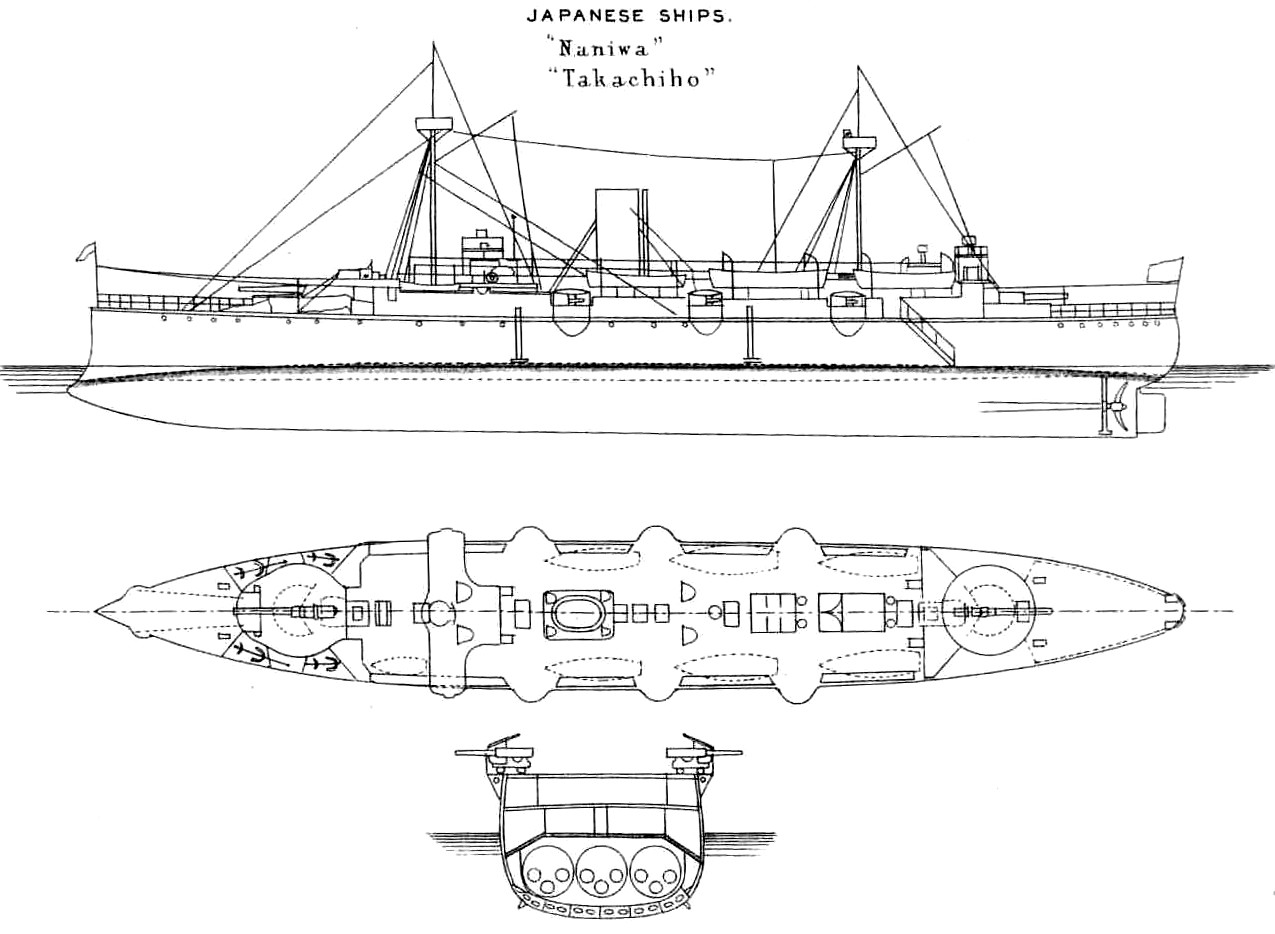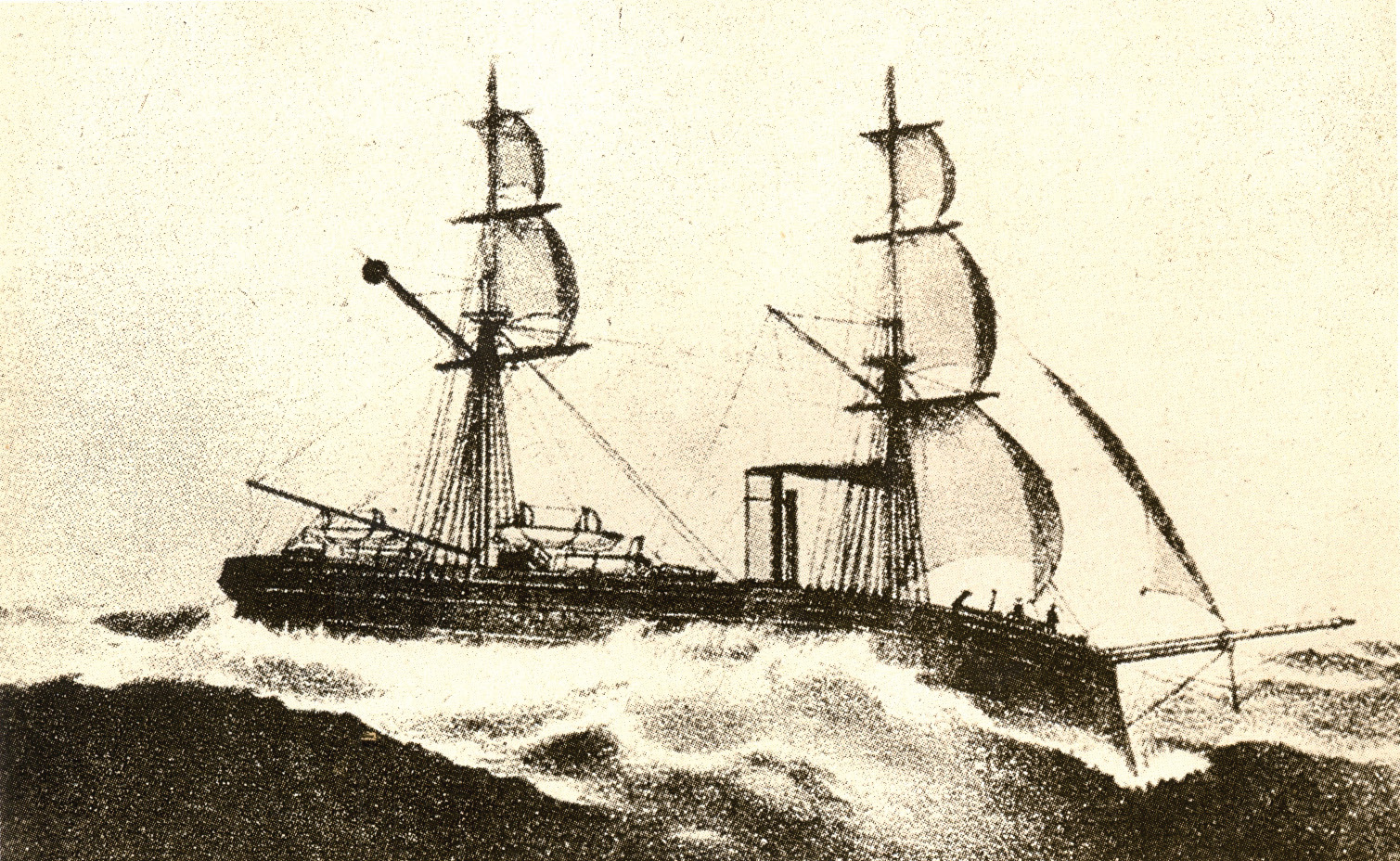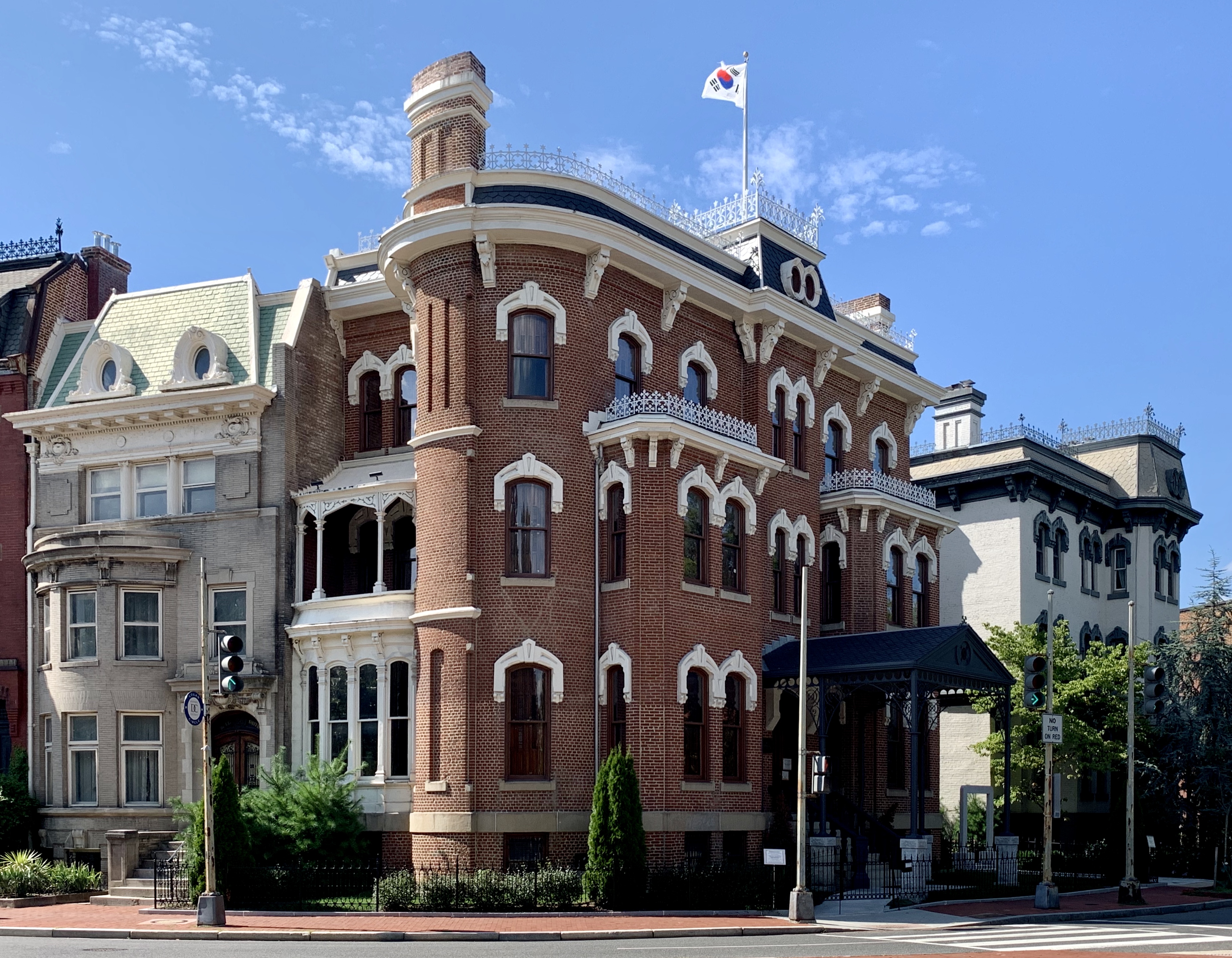|
Naniwa-class Cruiser
The two were protected cruisers built for the Imperial Japanese Navy (IJN) during the 1880s. As Japan lacked the industrial capacity to build such warships herself, the vessels were built in Britain. Both ships participated in numerous actions during the First Sino-Japanese War of 1894–1895 and in the Russo-Japanese War of 1904–1905. Background The 1876 Treaty of Gangwha forcibly opened up Joseon Korea to the Japanese, much like the Americans forced the Japanese Tokugawa Shogunate to sign the Convention of Kanagawa in 1854, and Joseon formally withdrew from its status as a tributary of Qing China. The Chinese made no significant response at that time and King Gojong began a modest effort to modernize the country to allow it to better withstand foreign pressure. This upset conservative elements in the army and the population which led to the Imo Incident of 1882 where the rioters attacked the Japanese Legation, forcing the diplomats to take refuge aboard a British ship and ... [...More Info...] [...Related Items...] OR: [Wikipedia] [Google] [Baidu] |
Armstrong Whitworth
Sir W G Armstrong Whitworth & Co Ltd was a major British manufacturing company of the early years of the 20th century. With headquarters in Elswick, Newcastle upon Tyne, Armstrong Whitworth built armaments, ships, locomotives, automobiles and aircraft. The company was founded by William Armstrong in 1847, becoming Armstrong Mitchell and then Armstrong Whitworth through mergers. In 1927, it merged with Vickers Limited to form Vickers-Armstrongs, with its automobile and aircraft interests purchased by J D Siddeley. History In 1847, the engineer William George Armstrong founded the Elswick works at Newcastle, to produce hydraulic machinery, cranes and bridges, soon to be followed by artillery, notably the Armstrong breech-loading gun, with which the British Army was re-equipped after the Crimean War. In 1882, it merged with the shipbuilding firm of Charles Mitchell to form Armstrong Mitchell & Company and at the time its works extended for over a mile (about 2 km) along th ... [...More Info...] [...Related Items...] OR: [Wikipedia] [Google] [Baidu] |
Japan–Korea Treaty Of 1876
The Japan–Korea Treaty of 1876 (also known as the Japan-Korea Treaty of Amity in Japan and the Treaty of Ganghwa Island in Korea) was made between representatives of the Empire of Japan and the Korean Kingdom of Joseon in 1876.Chung, Young-lob. (2005). ; excerpt, "''... the initial opening of Korea's borders to the outside world came in the form of the Korea-Japan Treaty of Amity (the so-called Ganghwa Treaty)''." Negotiations were concluded on February 26, 1876.Korean Mission to the Conference on the Limitation of Armament, Washington, D.C., 1921–1922. (1922). ; excerpt, "Treaty between Japan and Korea, dated February 26, 1876." In Korea, Heungseon Daewongun, who instituted a policy of increased isolationism against the European powers, was forced into retirement by his son King Gojong and Gojong's wife, Empress Myeongseong. France and the United States had already made several unsuccessful attempts to begin commerce with the Joseon dynasty during the Daewongun's era. How ... [...More Info...] [...Related Items...] OR: [Wikipedia] [Google] [Baidu] |
Zhili
Zhili, alternately romanized as Chihli, was a northern administrative region of China since the 14th-century that lasted through the Ming dynasty and Qing dynasty until 1911, when the region was dissolved, converted to a province, and renamed Hebei in 1928. History The name ''Zhili'' means "directly ruled" and indicates regions directly ruled by the imperial government of China. Zhili province was first constituted during the Ming dynasty when the capital of China was located at Nanjing along the Yangtze River. In 1403, the Ming Yongle Emperor relocated the capital to Beiping, which was subsequently renamed Beijing.Susan Naquin, ''Peking: Temples and City Life, 1400-1900'', p xxxiii The region known as North Zhili was composed of parts of the modern provinces of Hebei, Henan, Shandong, including the provincial-level municipalities of Beijing and Tianjin. There was another region located around the "reserve capital" Nanjing known as South Zhili that included parts of what are t ... [...More Info...] [...Related Items...] OR: [Wikipedia] [Google] [Baidu] |
Viceroy
A viceroy () is an official who reigns over a polity in the name of and as the representative of the monarch of the territory. The term derives from the Latin prefix ''vice-'', meaning "in the place of" and the French word ''roy'', meaning "king". He has also been styled the king's lieutenant. A viceroy's territory may be called a viceroyalty, though this term is not always applied. The adjective form is ''viceregal'', less often ''viceroyal''. The term ''vicereine'' is sometimes used to indicate a female viceroy ''suo jure'', although ''viceroy'' can serve as a gender-neutral term. Vicereine is more commonly used to indicate a viceroy's wife. The term has occasionally been applied to the governors-general of the Commonwealth realms, who are ''viceregal'' representatives of the monarch. ''Viceroy'' is a form of royal appointment rather than noble rank. An individual viceroy often also held a noble title, however, such as Bernardo de Gálvez, 1st Viscount of Galveston, who was ... [...More Info...] [...Related Items...] OR: [Wikipedia] [Google] [Baidu] |
Li Hongzhang
Li Hongzhang, Marquess Suyi ( zh, t=李鴻章; also Li Hung-chang; 15 February 1823 – 7 November 1901) was a Chinese politician, general and diplomat of the late Qing dynasty. He quelled several major rebellions and served in important positions in the Qing imperial court, including the Viceroy of Zhili, Huguang and Liangguang. Although he was best known in the West for his generally pro-modern stance and importance as a negotiator, Li antagonised the British with his support of Russia as a foil against Japanese expansionism in Manchuria and fell from favour with the Chinese after their defeat in the First Sino-Japanese War. His image in China remains controversial, with criticism on one hand for political and military defeats and praise on the other for his success against the Taiping Rebellion, his diplomatic skills defending Chinese interests in the era of unequal treaties, and his role pioneering China's industrial and military modernisation. He was presented the Ro ... [...More Info...] [...Related Items...] OR: [Wikipedia] [Google] [Baidu] |
Russian Empire
The Russian Empire was an empire and the final period of the Russian monarchy from 1721 to 1917, ruling across large parts of Eurasia. It succeeded the Tsardom of Russia following the Treaty of Nystad, which ended the Great Northern War. The rise of the Russian Empire coincided with the decline of neighbouring rival powers: the Swedish Empire, the Polish–Lithuanian Commonwealth, Qajar Iran, the Ottoman Empire, and Qing China. It also held colonies in North America between 1799 and 1867. Covering an area of approximately , it remains the third-largest empire in history, surpassed only by the British Empire and the Mongol Empire; it ruled over a population of 125.6 million people per the 1897 Russian census, which was the only census carried out during the entire imperial period. Owing to its geographic extent across three continents at its peak, it featured great ethnic, linguistic, religious, and economic diversity. From the 10th–17th centuries, the land ... [...More Info...] [...Related Items...] OR: [Wikipedia] [Google] [Baidu] |
Vassal State
A vassal state is any state that has a mutual obligation to a superior state or empire, in a status similar to that of a vassal in the feudal system in medieval Europe. Vassal states were common among the empires of the Near East, dating back to the era of the Egyptian, Hittite and Mitanni conflict, as well as ancient China. The use of vassal states continued through the Middle Ages, with the last empire to use such states being the Ottoman Empire. The relationships between vassal rulers and empires was dependent on the policies and agreements of each empire. While payment of tribute and military service is common amongst vassal states, the degree of independence and benefits given to vassal states varied. Today, more common terms are puppet state, protectorate, client state, associated state or satellite state. Historical examples Ancient Egypt The reign of Thutmose III (1479 BC-1425 BC) laid the foundations for the systems that functioned during the Amarna period of Egypt ... [...More Info...] [...Related Items...] OR: [Wikipedia] [Google] [Baidu] |
Legation
A legation was a diplomatic representative office of lower rank than an embassy. Where an embassy was headed by an ambassador, a legation was headed by a Envoy Extraordinary and Minister Plenipotentiary, minister. Ambassadors diplomatic rank, outranked ministers and had precedence at official events. Legations were originally the most common form of diplomatic mission, but they fell out of favor after World War II and were upgraded to embassies. Through the 19th century and the early years of the 20th century, most diplomatic missions were legations. An ambassador was considered the personal representative of their monarch, so only a Great power, major power that was a monarchy would send an ambassador, and only to another major power that was also a monarchy. A republic or a smaller monarchy would only send a minister and establish a legation. Because of diplomatic reciprocity, even a major monarchy would only establish a legation in a republic or a smaller monarchy. For example, ... [...More Info...] [...Related Items...] OR: [Wikipedia] [Google] [Baidu] |
Imo Incident
The Imo Incident, also sometimes known as the Imo Mutiny, Soldier's riot or Jingo-gunran in Japanese, was a violent uprising and riot in Seoul beginning on July 23, 1882, by soldiers of the Joseon Army who were later joined by disaffected members of the wider Korean population. The revolt broke out in part due to King Gojong's support for reform and modernization, as well as the employment of Japanese military advisors.Pratt, Keith L. ''et al.'' (1999). "Imo Incident" in Some sources credit rumors as the spark which ignited violence, where many Korean soldiers were worried by the prospect of incorporating Japanese officers in a new army structure. The trigger for the riot is largely attributed to a reaction about unpaid soldiers wages, who found sand and bad rice in soldiers' rations. At the time, soldiers could be paid in rice as it was used in place of currency. The rioters killed many government officials, destroyed homes of high government ministers and occupied the Changd ... [...More Info...] [...Related Items...] OR: [Wikipedia] [Google] [Baidu] |
Gojong Of Korea
Gojong (; 8 September 1852 – 21 January 1919) was the monarch of Korea from 1864 to 1907. He reigned as the last King of Joseon from 1864 to 1897, and as the first Emperor of Korea from 1897 until his forced abdication in 1907. He is known posthumously as the Emperor Gwangmu (). He was instrumental in the forced signing of the Treaty of Ganghwa (1876), an unequal treaty which would eventually pave the way for Japanese annexation of Korea. In 1895, his wife Queen Min was assassinated by Japanese agents, strengthening the king's antipathy towards the Japanese. Gojong declared Korea an empire in 1897, which ended the country's historic subordination to the Qing dynasty. His slow pace in issuing reforms led to conflict with the Independence Club, but he saw more success when carrying out the Gwangmu Reform along military, economic and educational lines. Later, Gojong was subjected to several assassination and abdication attempts; eventually forced to abdicate, he was confined in ... [...More Info...] [...Related Items...] OR: [Wikipedia] [Google] [Baidu] |
Qing Dyansty
The Qing dynasty ( ), officially the Great Qing,, was a Manchu-led imperial dynasty of China and the last orthodox dynasty in Chinese history. It emerged from the Later Jin dynasty founded by the Jianzhou Jurchens, a Tungusic-speaking ethnic group who unified other Jurchen tribes to form a new "Manchu" ethnic identity. The dynasty was officially proclaimed in 1636 in Manchuria (modern-day Northeast China and Outer Manchuria). It seized control of Beijing in 1644, then later expanded its rule over the whole of China proper and Taiwan, and finally expanded into Inner Asia. The dynasty lasted until 1912 when it was overthrown in the Xinhai Revolution. In orthodox Chinese historiography, the Qing dynasty was preceded by the Ming dynasty and succeeded by the Republic of China. The multiethnic Qing dynasty lasted for almost three centuries and assembled the territorial base for modern China. It was the largest imperial dynasty in the history of China and in 1790 the fo ... [...More Info...] [...Related Items...] OR: [Wikipedia] [Google] [Baidu] |

.jpg)






.jpg)
